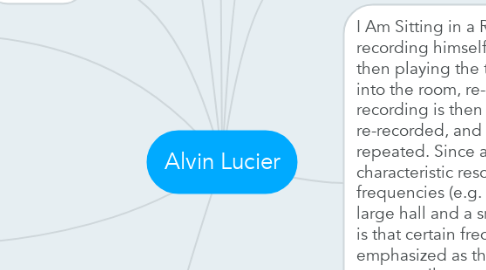Alvin Lucier
by Benjamin Williams

1. In consultation with Lucier himself, the curatorial team decided that the acquisition would include both the ability for others to perform the work in the future and an archival recording of the composer performing the piece himself
1.1. Stuart Comer, Chief Curator in the Department of Media and Performance Art, phrased it, the ability to perform the piece “allows it to exist in a constant state of imminence.” A collection of sound art is the endless possibility of bringing the work into fruition, a commitment to the work’s future status as having not just a past but also a present.
2. Music On A Long Thin Wire:
3. Sound Art
4. Music For Solo Performer: has become a key work of experimental music. Its setup, in which the brain waves of a solo performer are made to excite percussion instruments, has given the work a central place in the discourse on artistic sonification. However, only a small number of the authors making reference to the work seem to have studied the score, and even fewer have given thought to the score's implications for performance practice and aesthetic reflection. This paper pays detailed attention to these yet overlooked aspects, drawing on accounts of early performances as well as the authors’ participation in a 2012 performance led by the composer. We also trace the history of live-electronic equipment used for Music for Solo Performer and discuss the work's reception in sonification research.
5. Pioneer of sound art : first to use live electronic equipment for music as a solo performer, making him a pioneer
6. Music for Piano with magnetic strings - 1999
7. https://www.youtube.com/watch?v=fAxHlLK3Oyk
8. Born: May 14, 1931 (age 85) Nationality: American Known for: Sound art Notable work: I am sitting in a room
9. I Am Sitting in a Room (1965) : Lucier recording himself narrating a text, and then playing the tape recording back into the room, re-recording it. The new recording is then played back and re-recorded, and this process is repeated. Since all rooms have characteristic resonance or formant frequencies (e.g. different between a large hall and a small room), the effect is that certain frequencies are emphasized as they resonate in the room, until eventually the words become unintelligible, replaced by the pure resonant harmonies and tones of the room itself.
9.1. provides a view into the myriad of challenging questions raised by acquisitions of ephemeral artworks. How does a museum acquire an experimental music performance? What does the museum actually receive? And if the museum doesn’t acquire a physical object, what is the value of adding this work to the collection?


